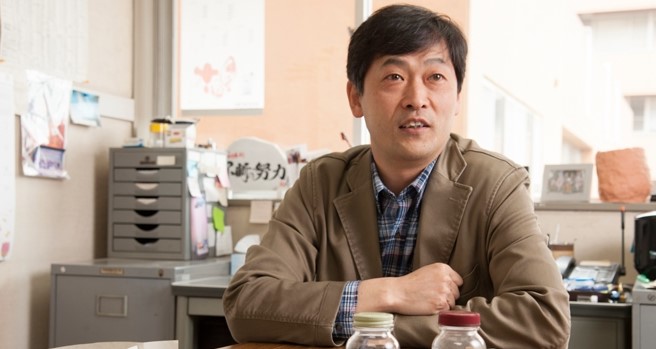
New organic electronic materials will reduce loads on the environment while also making our lives more convenient.
We conduct world-class research on thin films with new functions.
My research is focused on the development of organic compounds that can be used to create new materials. I want to create materials that can be practically applied to thin-film solar cells.
In our laboratory, we are developing new organic electronic materials. Conventionally, inorganic substances have been used in electronic materials, but replacing them with organic substances can make the manufacturing of electronic materials easier and cheaper, and allow new functions to be added. This is because organic substances are lighter, have better functionality, and impact the environment much less. Thus, this has been an exciting area of research.
Progress is also being made in the research and development of organic materials whose utility lies in their elemental characteristics. In this area of research, the goal is to first gain a deep understanding of the characteristics of the elements that make up a substance, then use these electronic and structural characteristics to create new molecular designs, which have never been seen before. The insights are also applied to build new organic material frameworks. In particular, organic materials containing silicon in their frameworks have been attracting attention for a while.
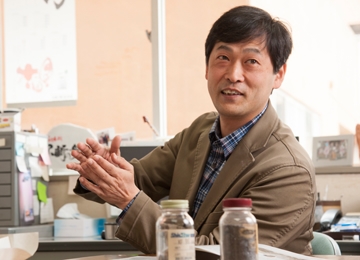
In our laboratory, we bring these two perspectives together to realize the development of new organic materials that can be applied for high-performance optoelectronic devices. We base these materials on new molecular designs combining the characteristics of elements such as silicon with those of functional π-electron systems. The goal is to develop photoelectric conversion and carrier transport materials for organic solar cells and organic electroluminescent devices.
Among the projects in our laboratory, I am the most interested in developing solar cells using organic substances. Organic thin-film solar cells are lightweight and flexible, and are expected to have a wide range of applications from solar power generation to mobile chargers.
We are trying to improve the energy efficiency, lifetime, and other features of functional materials so that they can be used to develop improved devices. Thinking about how materials can be used is also a task of "materials specialists".
The molecules we use in our research are totally new. In an emerging area of exploration such as organic devices, materials suggestions based on these new molecular designs are quite meaningful. The application of new ideas to create molecules the world has never seen is highly valued in organic chemistry precisely because it leads to new creations. At present, electronic device performances remain unsatisfactory in several areas, but we can improve their performance by optimizing their molecular structures, and through this endeavor, we are gradually making progress.
There have also been cases where chemists from outside our laboratory have created improved thin films based on molecular designs that we proposed. Such cases demonstrate the importance of creating new molecular structures that everyone can use. They can also give us new ideas for creating something even more interesting. Further, our pursuit of the development of a material should consider how it could be used in the real world. Rather than replacing old devices with those made with new materials, I predict there will be finer grades of differentiation, such as differential uses for various materials within existing systems.
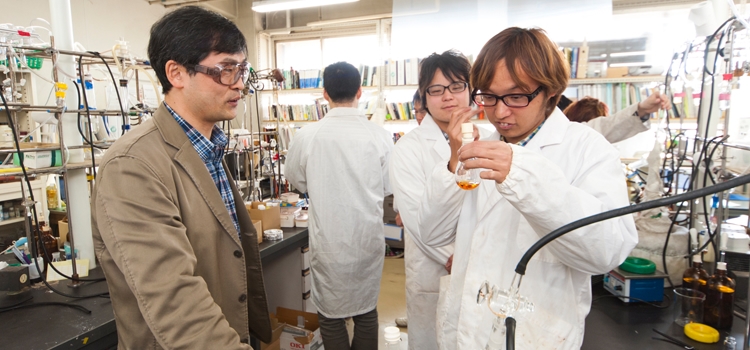
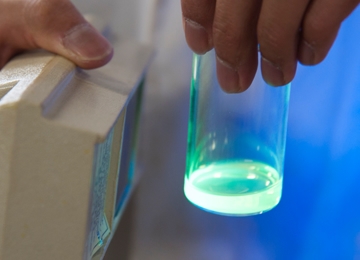
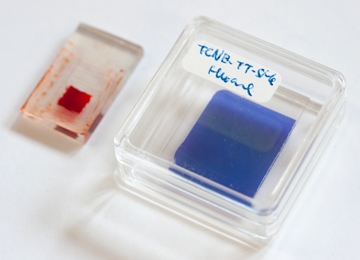
I want to create things that are useful in society. My main goals are to develop novel materials with practical applications and train the next generation in this field.
My current research was inspired by advice I once received from one of my Professors in graduate school. He specialized in organic silicon chemistry. At the time, methods for introducing silicon into organic substances were still limited, and I thought that working on them would be interesting and different from what other laboratories were doing. Silicone and other organic-inorganic hybrid materials that contain silicon have the potential to be turned into completely different materials. This is why we have focused our research on the chemistry of silicon for so many years. Now, we are trying to create new organic compounds using a variety of elements.
The appeal of this kind of experimental research is that, unlike ideas on paper, you get a sense of accomplishment when a compound you created takes on a new function, just like your simulations predicted. In Hiroshima, manufacturing is a tradition, and the students at Hiroshima University are very talented. The city and the university provide a good environment to work on all kinds of projects with numerous scientists. I want to keep making progress in my research, so it can be practically applied in actual devices. In the end, I want to contribute to society, including by fostering the abilities of the next generation.

 Home
Home